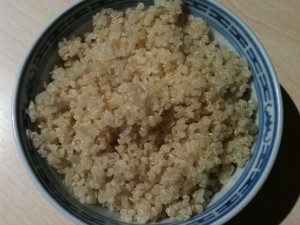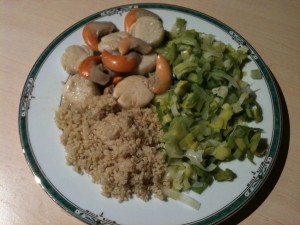
Last week, in Part 1, I told you about the first nutritionist I saw when I decided to go on a diet (after listening to weight-loss hypnosis tapes first, remember), a guilt-inducing naturally skinny Asian doctor. The second person I saw was much better – a very smiley touchy-feely doctor from Martinique, Marie-Antoinette Séjean, who is the author of two diet and nutrition books, and who, although slim, was obviously not a natural skinny. I told her about my previous experience and she said not to worry, that we’d work something out together. She told me to write down everything I ate during the next two weeks. She also reassured me that I wouldn’t have to give up anything permanently, including red meat, prunes and foie gras.
In the meantime, she suggested several things I could do to lose weight:
-

Chinese bowl with quinoa Cut out all wheat-based foods for 3 weeks because wheat has a bloating effect. She suggested rice, quinoa (I’d never heard of it but now really like it), buckwheat and polenta instead. She reassured me that it was only for three weeks.
- Cut out raw vegetables for 3 weeks for the same reason.
- Divide my plate into four: ¼ protein, ¼ carbs, ½ cooked vegetables.
- Don’t worry about actual quantities, except for the carbs, which should correspond to the contents of a Chinese bowl (when cooked) and should be eaten at every meal.
- Make sure I was getting 200 g of protein for breakfast. This is because the protein stops you getting hungry mid-morning and when you lose weight, you lose fat and not muscle. We decided on an egg, a yogurt (they come in individual 90 g pots here) and a 100 g pot of fromage blanc (this is a soft, fresh cheese, vaguely like cottage cheese but not salty, with roughly the same nutritional value and consistency as yogurt), 2 pieces of buttered Swedish bread (even though it contains some wheat, but I’d been eating that for breakfast for years and couldn’t bear the thought of giving it up) and a piece of fresh fruit or small glass of fresh orange juice, eaten AFTER the protein.

It all seemed very reasonable and manageable. I had told her I wasn’t interested in losing weight quickly, but I did want it to be permanent. I asked about exercise (long-forgotten apart from cycling in the summer) but she said not to worry about it for the moment. She weighed me and took all my measurements. She explained that it’s important to look at body measurements as well and not just weight, because you stay the same weight on the scales but lose centimetres around your body. I made an appointment for two weeks’ time, just before Christmas! It was only when I got home that I realised I hadn’t mentioned the wine. So I decided to cut down to one glass at lunch and two at dinner, except for oysters on Sundays when we usually drank a bottle of sancerre between us.
Next installment in two weeks’ time! You can start writing down what you’re eating every day as well. Be honest with yourself and don’t leave anything out. Remember, the aim is not to eliminate anything, just to be really aware of what you’re eating. But you might just find that you’re cutting down anyway …
Dr Marie-Antoinette Séjean, 81 rue des Belles Feuilles, 75116 Paris. 01 44 05 16 15



I haven’t stopped thinking about this post since I first read it.
Do I dare take your lead and write down everything I eat? I am sure that if I have to write it down that I would modify what I eat. I am too embarrassed to admit even to myself how poor my diet is. Did you use your iPhone to record what you ate?
Hi! That of course, is the beauty of the method. If you are too embarrassed to admit even to yourself how poor your diet is, you’re halfway there. If you modify what you eat so that you can write it down, you’ll find the kilos just falling off! That’s what happened to me. And it’s strange, I gradually didn’t seem to want them any more. Dr Séjean gave me a sheet of paper divided into columns: breakfast, lunch, dinner and extras. I found it useful to be actually able to see everything at a glance, written in MY WRITING, which has a far greater impact than a printed version, which could be someone else’s!
Next time, I’ll talk more about how to resist eating too many extras. One way is to go and sit in a place that you find relaxing. You sit there with your eyes closed, just letting your mind wander for ten minutes. More often than not, the desire to eat something will have disappeared!
Let me know.
I so badly need to lose weight. I started using http://www.calorieking.com.au/ to record what I’m eating which includes how many carbs and protein etc I’m having. It’s kinda scary when I see it in writing! Now if I could just figure out how to stop overeating. 🙁
Have you tried the hypnosis tapes? I really think that was the secret. When I started to diet, I felt completely ready and it was easy. Perhaps you could note down at what time of the day and under what circumstances you are overeating so as to determine a pattern. Then you can find something else to do on those occasions that could be just as rewarding. One of my problems was the amount in my plate. If it was there, I’d always eat it and if I could serve myself again, I always did. Having the entire côte de boeuf on the table was very tempting. Cutting it up and serving it in the kitchen means I just eat what is on my plate, as you do in a restaurant. If you don’t eat much at meals, but snack a lot, you could maybe find more healthy snacks. Dr Séjean said that at least 200 g of protein would help to calm the snacking. HTH.
Portion size is definitely my problem. So task number one for me is to reduce my portions and never have seconds!
Then increase the vegetable portion so that you still have a sizable plate. And chew slowly. I’m a super fast eater and the problem with that is that your stomach doesn’t have time to connect with your brain to tell you that you’ve had enough. In Australia, where I didn’t really have a weight problem (apart from the usual teenage years), food was always dished up in the kitchen and then brought to the table whereas in France, the dishes are all there and you are always encouraged to finish everything. I find it’s not a good idea to eat in the kitchen, but to always set the table (even if you’re eating alone) in a separate room if you can.
All good points, I will give it a try, thanks!
Very interesting, and appears to be quite a sensible regime.
And that, from a natural skinny!
Can you still have coffee?!!?! Please tell me there’s coffee.
Actually, you don’t cut out anything. You can still have coffee and wine and foie gras and côte de boeuf and lasagne and oysters on Sunday with fresh homemade bread and butter! Everything is in the proportions and the frequency. I like good food too much to have gone on one of those diets where eating is no longer a pleasure.
I very badly need to lose weight too. I’ve only just started reading about how you lost all those kilos, you looked like a natural slimy to me. Can’t wait for next Tuesday so we can talk about it and in the mean time I’ll look for some mediation tapes.
Deceptive, huh! If you’d seen me two years ago, you would have known I was definitely not a naturaly skinny. I love the way you wrote “natural slimy” and not “slimmy”, by the way, and also “mediation” and not “meditation”. Now, is this dyslexia or should I look for a deeper meaning?
No, and there’s no need to look for a deeper meaning, just me after a hard day at work. Kids !!!
I’m looking forward to getting on this diet I’ve been on so many and never seem to stick to them. When you say not to eat wheat, is that bread and cereals? Can I continue to eat oats flakes, and grain?
Yes, it just means wheat in bread and cereals, couscous, taboulé, etc. You can certainly continue to eat oak flakes and any grains other than wheat. There’s a difference in British English, isn’t there? By wheat, I mean just “blé”.
I’m trying the 5:2 diet after reading your blog it is helping me. I have ordered the book from Amazon and I am into my second week now 3kg off to date. I tried the baked eggplant, red onion, capsicum and zucchini, and tomatoes. I also tried quinoa for the first time.
I have cut out wheat and bread so any more tips are most welcome.
Hi Dianne, I’m so pleased that my blog is helping you. Polenta is another dish I use often. So easy to prepare and you can keep it in the fridge to be fried up with a little olive oil on non-fast days. We really find that sticking to the same foods more or less every fast day is helpful because it means that you are not thinking about food or cooking. We skip breakfast (just black coffee with sweetener), have two eggs (usually omelette), steamed or raw vegetables and a piece of fruit for lunch, then a yoghurt, 20% fromage blanc (Yoplait makes it in Australia, I think), more steamed vegetables and another piece of fruit for dinner. I cook the vegetables in a tupperware container in the microwave until just cooked. We typically have 3 vegetables such as cauliflower, broccoli, zucchini, green beans and carrots. Sometimes I add wild mushrooms or sorrel to the omelette. I also steam fennel, endives and leeks, depending what’s in season.
The big advantage of a diet like this is that if you “mess it up” one day, you haven’t “broken your diet” and can just carry on from there.
One thing that Jean Michel appreciates is that he no longer needs to finish off the box of chocolates or packet of biscuits once he has opened it. Make sure that on the non-fast days, you are having foods you like so you don’t feel you are restricting your diet all the time.
I look forward to hearing how you get on. If you are on Facebook, there is a helpful group called 5:2 intermittent fasting.